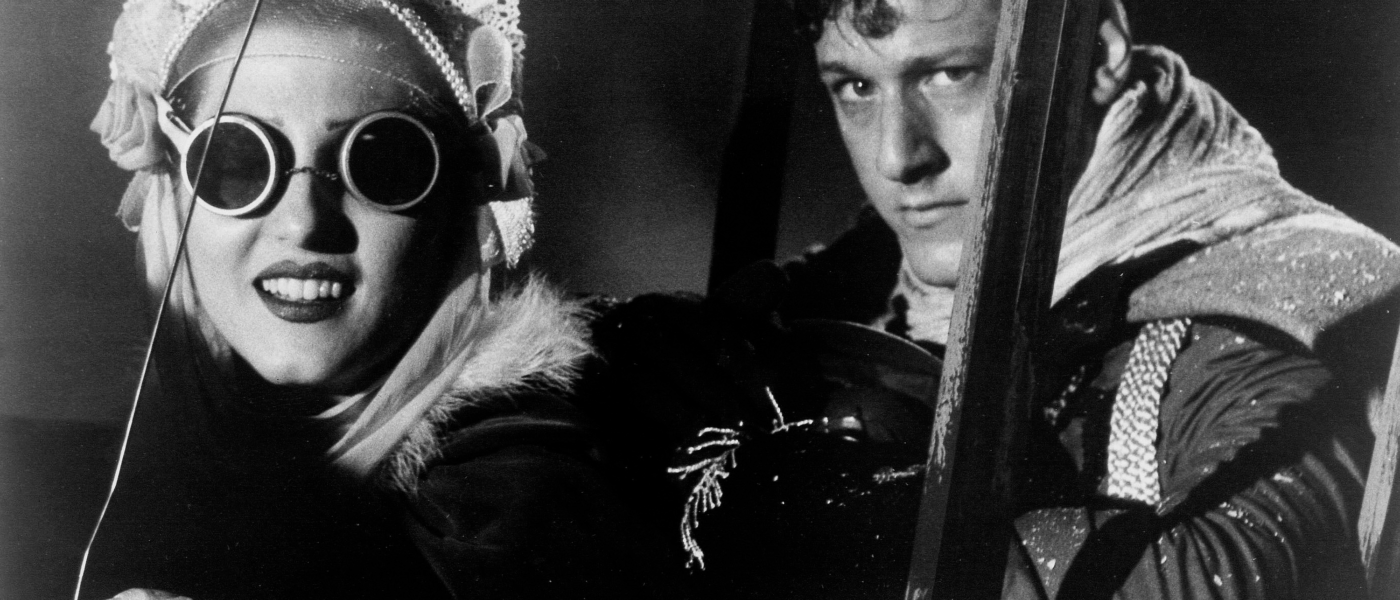Coloring Over The Lines In Near-Silent Black And White
DIRECTOR: GUY MADDIN/CANADIAN
STREET DATE: MARCH 6TH, 2024/KINO LORBER & ZEITGEIST FILMS
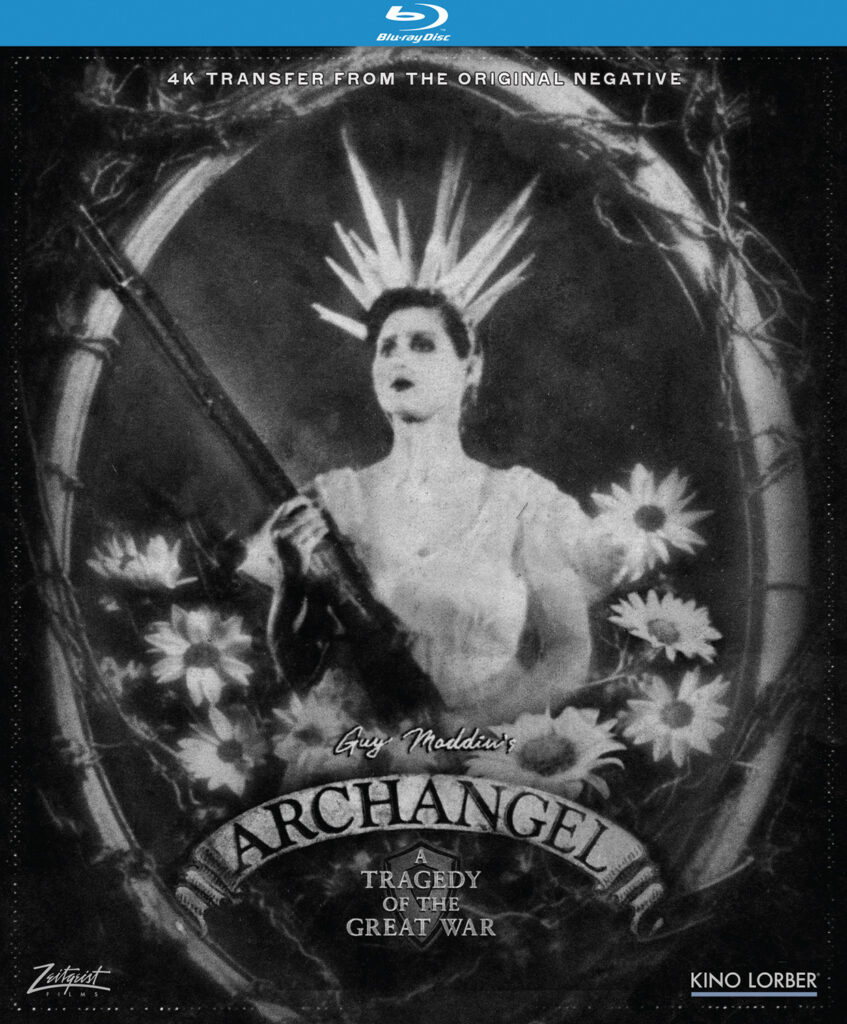
Very few films capture the feverish reality of dreams better than Guy Maddin’s 1985 short film The Dead Father, which in 25 somehow lengthy minutes, time itself amorphous and irrelevant through its hallucinatory-intensified aesthetic, manages to impress upon viewers the sensation of subconscious anxiety with the force of directly visualized experience. All the more remarkable for being Maddin’s first effort on film, its bleary-eyed protagonist’s stressful position of constantly warding off unwelcome visits from his recently departed dad, apparently bored at the cemetery and refusing to just stay buried, undoubtedly mirrors the common experience of many who have lost parents or close ones through the years. Although it’s been almost exactly 31 years since my own mother passed away, the anniversary of her death having itself passed the first of this very month, to this day I continue to encounter her in various dream-guises: most recently as a librarian at some sort of post-digital archive for computer websites that have vanished from the internet, ironically stored in roll-top metal drawers on a card-filed visual catalog.
Mom? So that’s what happened to my old MySpace account…
The dead father was shot in the same evocation of black-and-white silent film that marked his first two features, Tales from the Gimli Hospital (1988), digitally restored in revised “redux” form in 2022, and now Archangel, receiving a similar 4K scan and visual upgrading. Potential moving forward in the filmography of Guy Maddin will find the director graduating to color and early talkies with his mountain psychodrama Careful (1992), but his initial films, set in the same “Dominion of Forgetfulness” representing frontier Canada and post-Great War northern Russia, respectively, are made with an individualistically identical artistic energy, part-story, part-dream, half-silent, half-sound, that Maddin aptly describes as “coloring over the lines”. Except without color, mainly, and with sound that only partially corresponds to the image. Vaseline, polyester, and potato flakes; plaster models; cardboard, spangles, and gold spray; syrup, ketchup and link-sausages; Pepsi bottles made into bombs and 78 records spun at 33 or even 16 rpm; an abandoned warehouse next to a skateboard rink doubling for a field of battle the time forgot; with off-duty professionals, doctors, and grad students dressed in half-stitched costumes and wearing elaborately-plumed headgear, running back-and -forth over seam-visible sets and painted backdrops; somehow all capturing the feverish reality of the Great War still being fought after the Armistice.
Or, contrariwise, have one’s dreams been scanned in 4K resolution and uploaded to a Blu-ray disc?
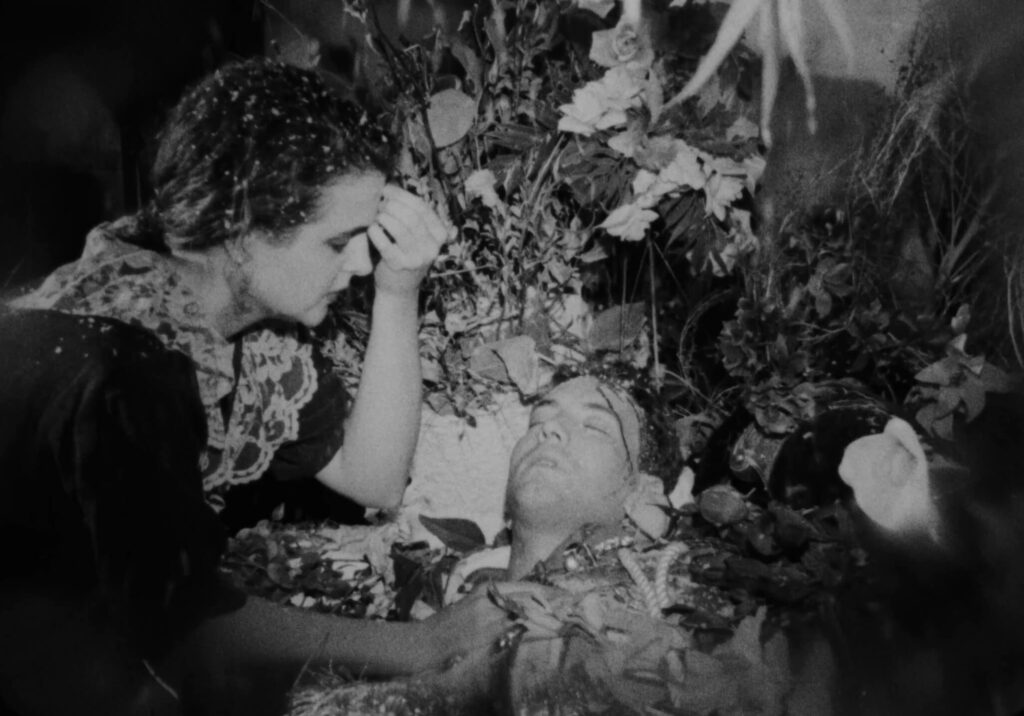
It somehow doesn’t matter as the scene hazily unfolds through the fog of night at mid-sea, with one Lt. John Boles (Kyle McCulloch) arriving by boat from the late field of battle, minus a leg, bereft of much memory, but carrying the remains of his recently departed wife Iris in an urn, which the captain of the ship (Victor Cowie) inspires Boles to hurl overboard, along with the similarly but differently intoxicating contents of the crew’s contraband bottles. Periodically forgetting his prosthetic lower extremity while determinedly hobbling through a shifting landscape of flashing explosions and heavily falling snow, Boles gradually takes countryside residents with lovelorn Danchuck (Sarah Neville), cowardly Jannings (Michael Gottlieb), their adventurous son Geza (David Falkenburg), and grandmatronly Bata (Margaret Anne MacLeod) before soon encountering whom he perceives through his mental confusion as the reincarnation of his late wife in the battle heroine Veronkha (Kathy Marykuca).
But the fog of both battle and the mind thickens through revelation of Veronkha’s annulled marriage to amnesiac Philbin (Ari Cohen), who under the care of a concerned doctor and mental specialist (Michael O’Sullivan) continues to believe that he and his former bride are still eternally on their honeymoon, by cloud-hopping aero-ride over the onion domes of Murmansk, to a rustically luxurious hotel in the greater metropolis. Even as Veronkha/Iris, Captain Philbin, and Lieutenant Boles continue to ward off slavering Huns and berserker Bolsheviks in the blizzard blasted trenches and bombshelled fields of Archangel, long after the battle has ceased and the Armistice has been signed, their romantic entanglements real, imagined, forgotten, and dreamed persist through a tangled skein of memory, trauma, and fantasy.
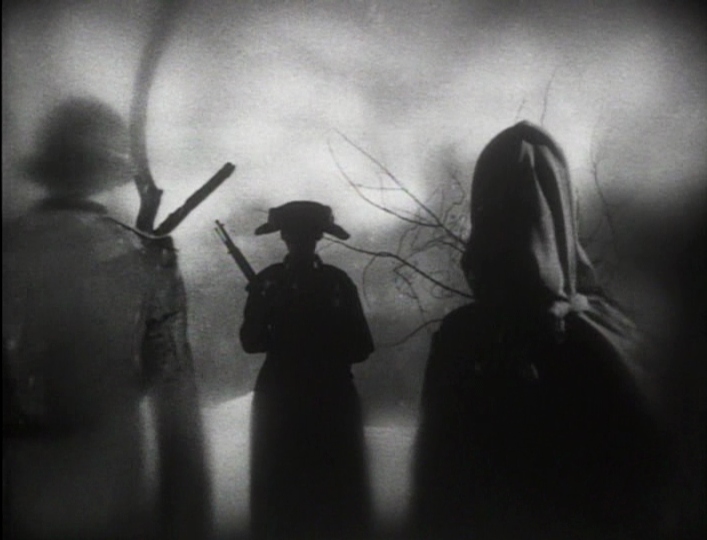
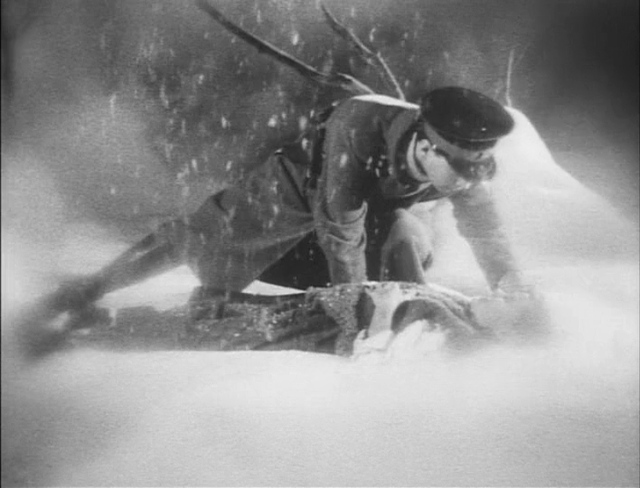
Subtitled “A Tragedy of the Great War”, its central cameo-image of Veronkha/Iris with ice-shafts of flaring light emerging diadem-like from her head, while holding a rifle in a wreath garden of sunflowers – calling back to the “illuminated” candle-tableau symbolically-staged for the benefit of propaganda before the international forces descending on Archangel lurch into confused battle – Guy Maddin’s creative/artistic sandbox/playground does refer to an actual historical incident where decamped German soldiers, Russian revolutionaries, counter-revolutionaries, and diverted Allied forces converged on the remote Northern outpost months after the signing of the Treaty of Versailles. Never fully explained, as if the combatants themselves were suffering from a form of collective amnesia, forgetfully doomed to fight the Great War long after it had ended, Maddin’s entirely unique sensibility here finds the possibly perfect subject matter and backdrop to his deranged love triangle between romantically confused war veterans.
Phonographs scratching out tinny tunes across the battlefield, crossed radio signals scrambling already confused brains, megaphone amplifiers and receivers conveying stentorian orders in intricately jumbled purple prose; along with an advance of white bunnies dropped into wood-carpeted stone-crevices, apparent corpses rising from advanced hypothermia, and a quivering cactus erupting in animated spider-spray, Archangel consistently demonstrates throughout its again somehow epic length of 77 minutes, both longer and shorter than a particularly vivid night of dreaming, that inspiration of the moment can be artistically unified to a completely bizarre yet entirely convincing historical truth. As the final shot on a surviving Lieutenant Boles shows, displayed as a hero in his native Canada on a flower-strewn and female-pulchritudinous parade-float, the framed-image jarringly jump-cutting within the metal grooves of a rifle barrel, the accompanying machine gun-rattle isolating Boles in a final, held, black-iris rack-out, demonstrates precisely where the physically and mentally wounded soldier will psychologically remain for the rest of his life.
Pro-war in the same way that Maddin’s subsequent, Leni Riefenstahl-inspired mountain melodrama Careful was intended to be pro-repression, the delirious layers of distance and irony from its subject matter, like the “warm and fuzzy” blankets of radio static piercing the howling Winnipeg winter storms of Maddin’s childhood, which he later claimed inspired his aesthetic, here invents, improvises, and “improves” upon the germ of reality and history that inspired it, towards a greater truth about human conflict and the battlefield of the heart. If Archangel, like Tales from the Gimli Hospital and The Dead Father before it, plays like a lost relic from a forgotten era of filmmaking and storytelling, rediscovered in some moldering attic, closet, or basement, their decayed visuals and imperfectly-synced soundtrack – in one long scene with Veronkha and Lt. Boles riding in a stationary sleigh through a rear-projected snowscape, the forgetful pair appear to be communicating through telepathy – nevertheless conjures up the artistic spirit of long-ago and far-away with the emotional immediacy of a crank-held camera directly photographing the mind-projected subconscious.
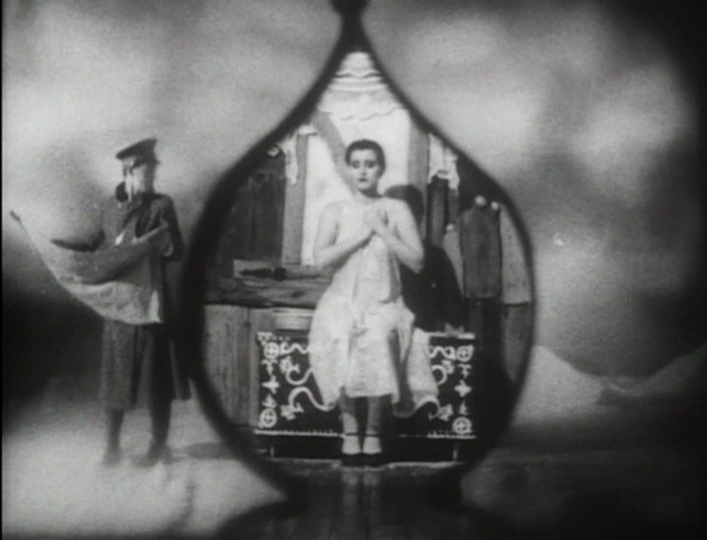
Wholly embracing the creative impetus of its making and the “happy accidents” of its production, director Guy Maddin reports in his 2023-recorded commentary, accompanying this Blu-ray restoration, that not only did the film’s lengthy schedule of 35 days allow him to shoot the film in sequence, but he was also afforded the frequent opportunity to change the story- or character-direction of the film based on apparent mistakes. Banning the use of the word “continuity” as the “c-word” among his cast and crew, Archangel does again replicate the dreamlike experience of not knowing what could possibly happen next, alongside its more meticulous Sergei Eisenstein-inspired dramatic framing and cutting, and its Josef von Sterberg-level of background detail and art design.
No matter how many times I’ve seen this particular Guy Maddin film among both his previous and later films, and I think I must have seen it at least a half dozen times by this point, Archangel seems to carry a level of complexity in viewing that strangely mirrors the perpetual amnesia of its mentally-addled protagonists, to the point that every time I’ve watched it I’ve effectively seen an entirely new and different movie. Which possibly means that if I watch it again in 2 or 3 years, say, the tabula rasa of my own addled viewing memory may allow further yet undreamt, over-the-line colorings in its half-silent, black-and-white artistic extremities. Stretched to the very visual limit, perhaps, in this best-of-all-dreamed worlds and 4K restoration, one might simply celebrate this admirable higher resolution version of Archangel as possibly promising future visually upgraded trips – Failed Fairy Tale? Homoerotic Peep-Show Hockey Crime Thriller? Vampire Ballet? – to Guy Maddin’s indelible and sui generis netherworld of film, dream, and the indefinable in-between.
Images in this review are used only as a visual reference to the film and do not reflect the picture quality of Kino Lorber and Zeitgeist Film’s Blu-ray of the 2023 4K transfer and restoration of Guy Maddin’s Archangel (1990).


